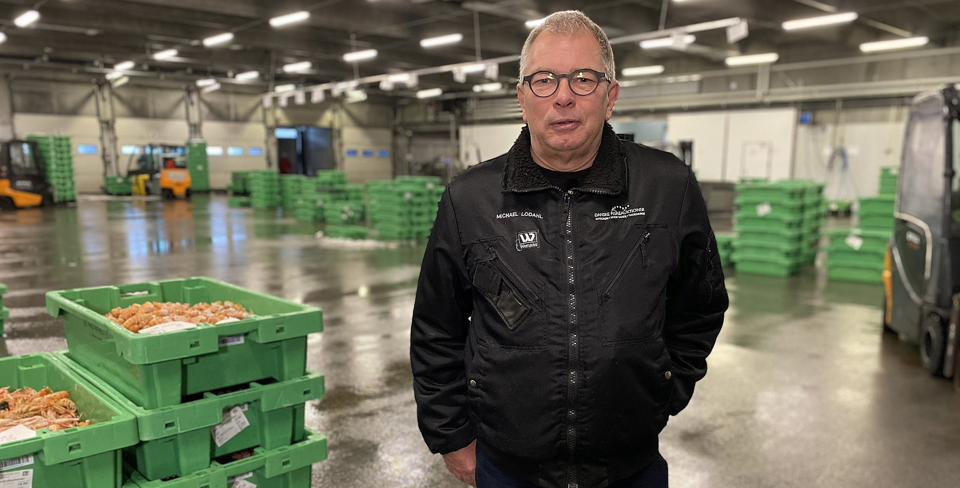Fish grading based on documentation
Case Story: Danske Fiskeauktioner

Danske Fiskeauktioner in Thyborøn in Denmark offers a unique service to fishermen beyond their core business of electronic bidding. This service allows fishermen to have their catch graded and sorted.
The sorting takes place on a grader with a software system that ensures the exact settlement for the fishermen and provides the necessary documentation to the authorities.
Scanvaegt has provided the hardware, while Accuratech has designed the software.
When fishing vessels from countries like Holland and Belgium have a full load of freshly caught fish from the North Sea, it is not profitable to sail home with the catch. Time is money, so instead, they sail to Thyborøn in Denmark, where they land their cod, plaice, flounder, and monkfish, which have not yet been graded by species and sizes.
Among the companies capable of sorting fish, Danske Fiskeauktioner has the largest capacity in the area and is one of the few that can grade flatfish by machine, ensuring the precise weight of each individual fish.
Full traceability and precise settlement
The company, based in Thyborøn with branches in Thorsminde and Hvide Sande, has nine grading systems, each with a capacity of 900-1200 kg of fish per hour. Significant improvements have occurred since 2021 where the old graders were replaced with new graders with integration to the ScanPlant NG software system. This combination is the key to precise counting, full traceability, and essential documentation.
"The significant difference is that we can collect data on our new graders, which we couldn't on the old ones. Now we can document the catch down to the detail, obtaining data on the exact weight of each individual fish. The improvements ensure full traceability, accurate settlement for the fishermen, and the mandatory documentation for the Fisheries Authority," explains CEO Michael Lodahl from Danske Fiskeauktioner.
Documentation includes the name of the fishing vessel, the geographic fishing area, fishing equipment, catch date, species, and sizes. Some of this data is provided by the fishermen to the auction company and is recorded in the system before grading begins.
The mixed catch, averaging 20 tons per fishing vessel, is delivered in crates at the quay. After manual coarse sorting by species per crate, the crates are automatically tipped onto the machine, which grades the fish and distributes them into new crates with labels. Each batch receives a unique lot number.

The improvements ensure full traceability, accurate settlement for the fishermen, and the mandatory documentation for the Fisheries Authority

CEO, Danske Fiskeauktioner.
A system created for traceability
The next step is grading by size. This occurs on the grader line, where the operator finds the lot number on the new screen. With one click, they enter the fish species and get the green light to manually place the fish on the conveyor belt to the new grader. Each fish is quickly weighed and automatically graded by size into one of the ten containers takes place a few seconds later.
From there, the fish land in crates and tubs, applied with labels containing information on traceability and net weight. The next round takes place in the digital auction house, where bids are electronically placed by approximately 280 different buyers.
When documentation means everything
Scanvaegt Systems has delivered and installed the grader. The software has been developed on the ScanPlant platform by Accuratech, of which Scanvaegt is a co-owner.
"For several years, we have been looking for a flexible IT system that can document our work in an easy, fast, and efficient manner. We have it now, and it is tailored to our business. We have a good collaboration with Accuratech, who does not give up the task until we reach the goal," emphasizes Michael Lodahl, also mentioning that Scanvaegt is strong in the service sector.
Last year, 5.9 million kg of fish were graded on the Danske Fiskeauktioner’s lines in Thyborøn.

All relevant information is in the system
The system has been specifically developed for handling fishing catches and includes the following features:
- Crate label with barcode
- Catch reports with totals per species/size:
- Subdivided by crate numbers
- Subdivided by catch date/quality
- Short catch report - only totals per species/size - Weight limits for filled crates.
It's about credibility
"With the new data collection setup, we have even better control over our part of the business. In this case, it's not so much about increasing revenue because it's challenging in our industry. It's more about our credibility. We help the fishermen with grading and can document everything, which means the fishermen trust us and come back," says Michael Lodahl.
Read more about related products:
Contact our food industry experts

International Business Manager - Food Industry
Automatic weighing systems
+45 4053 4900
Have a question? Request a callback



